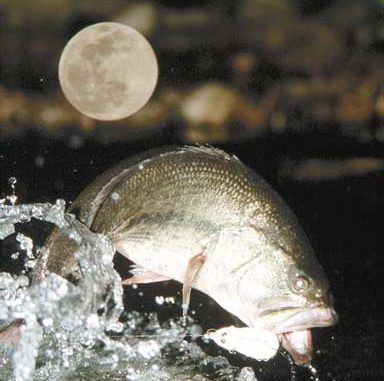
Night fishing for largemouth bass is the way to beat July’s heat and have lunker fun
My son’s buzzbait, unseen but heard, came toward the boat with a gurgling sound one July night at Lake Norman.
Between the boat and shore, a whoppin’ splash electrified the night and the boy said with a shout: “Dad, Dad, I’ve got one.”
Then a teen-ager, my son had been reading about fishing for largemouth bass at night.
“Have you ever fished for bass at night, in the dark?” he said one day.
“Sure,” I said. “You’re grandpa and I used to fish at night all the time. It was the only time we fished for bass, partly because Dad worked all day, partly because it was about the only time anyone fished for bass where I grew up, and partly because it was and still is a great time to catch bass.”
It wasn’t too much longer before my son and I headed for Lake Norman to try bass fishing at night and he caught the bass on a buzzbait.
Particularly in the dog days of summer, night is a great time to fish for bass and Lake Norman draws lots of night-time anglers. Robert Lemmond, of Mooresville, lives within a stone’s throw of Lake Norman and fishes often at night.
“Come June, July, August, fishing at night is the best way to avoid the crowds at Norman,” he said. “Lake Norman is a popular place for water-skiers, personal watercraft users. But after about 7 p.m., things start to quiet down.”
In addition, bass that may have been spooked by daytime activity at the lake have to forage sometime. And night time is prime time.
Darkness provides cover for foraging bass not otherwise available at clear-water lakes such as Norman.
Night-time anglers often debate the full moon vs. new moon impact. My experience has been the major impact of the full moon is better vision; otherwise, just go fishing.
As all of us know, mid-summer at the Carolina Piedmont can get pretty warm.
“I just don’t want to be out there when it’s 90 degrees,” Lemmond said. “So when I go at night, it’s lots cooler. I think the fish are more active, too, once it cools down a little.”
Dan Duval, of Charlotte, is another fan of Lake Norman night bass fishing.
“During the summer, night-time tournaments usually weigh in several pounds more fish than day tournaments,” he said. “The bigger fish are just a little more active after dark.”
Piers, docks and lights
Lake Norman bass anglers often seek lighted piers for night bass.
“Look for lighted piers off the main channel,” Lemmond said. “Those are the best spots.”
“I fish the lighted areas shallow, from 1- to 5-feet deep, and deep areas, from 5 feet to 15 feet,” Duval said.
At night, lighted piers are easy to find. Move carefully from one pier to the next and fish the lighted ones hard. Pre-scouting during the day can help locate piers likely to be lighted at night. And a well-prepared plan once the sun goes down may be key to a safe night on the water.
“Not all the docks are equal,” said Captain Gus Gustafson, a multi-species fishing guide at Lake Norman, of fishing docks at night. “Some are much more likely to hold fish than others.
“Even docks with lights are not all the same. The lights have to be shining in the water and the closer to the water the better. Look for docks with rod-holders. Some docks at Lake Norman have solar-powered fish feeders that distribute some sort of fish food at intervals. Those are the best docks.”
“Midway Marina is a good spot to fish lighted docks,” said Lemmond, who usually launches his boat at the Pinnacle Access Area near N.C. 150. “There are always fish hanging around there.”
Of course, there are lots of other lighted marinas at Lake Norman, but Midway is close to Lemmond’s preferred launch area.
He uses large black worms rigged Texas-style for night fishing.
“I use a big black worm, a 10-incher,” Lemmond said. “Zoom makes 10-inch worm, in black, purple and black grape. Those are all good colors.
“I rig it on a 1/4-ounce weight with a screw-on head. I cast it or skip it as far under the pier as I can. Then, slowly, I drag it toward the pier pilings. If I can, I make the worm bang against a piling and let it sit. That’s when you’re likely to get bit.”
If the large worm does not work, Lemmond said he sometimes uses a larger weight and a smaller worm. The large weight helps keep the smaller worm from rising off the bottom.
Duval also uses big worms at night.
“I Texas-rig 8- to 12-inch worms and lizards at night,” he said. “I fish them at docks and points.”
Duval also relies on large jig-and-pig combos for night fishing at Lake Norman.
“I use 5/8-ounce jigs with big chunk trailers,” he said. “For trailers, I use black, black and blue or black and red.”
A heavier weight than usual works well for night anglers. In the dark, line watching as a means of detecting a strike with a Texas-rigged lure or jig and pig doesn’t work, at least it doesn’t work well. A 1/2-ounce weight or more keeps the line tight between rod tip and lure, thus increasing sensitivity and compensating for the loss of visual cues.
Topwater approaches are lots of fun and work very well for night anglers. Lemmond said,
“Topwaters are prime when I first get on the water, say about 7 p.m. in the evening,” he said. “A black buzzbait or a Spook Junior, both of those work well.”
In low light, a steady or rhythmic retrieve works best. If walking the dog with a Spook Junior, maintain a constant and regular pattern. The venerable Jitterbug also remains an excellent night-time lure for bass. A square-lipped, shallow running crankbait — something along the lines of a Balsa Model B or a Mann’s Minus One — with a slow, steady retrieve is another topwater style approach worth trying.
“The best spots for topwater action are along laydowns off the main channel and near the boat docks,” Lemmond said.
Gustafson also likes using topwater lures but had some other choices.
“Topwaters are a good way to go,” he said. “Noise is a big attractor at night. I like a Tiny Torpedo. Topwaters should be worked lots slower at night than in the daytime.”
Forage also is a key to locating Lake Norman bass. Lemmond said.
“It gets dark about 9 p.m.” he said. “That’s when the bugs come out. In turn, the little fish turn on chasing the bugs. And then the bigger fish — like bass — become more active, chasing the little fish. It takes about an hour for the cycle to take effect.”
Gustafason outfits his boat with a Hydro-Glo light, suspending it in the water to attract fish.
“Those lights really are amazing,” he said. “You can anchor anywhere you think might be productive and put the light in the water, especially in calm winds and stable weather. In a few minutes the little fish will start to show up.
“Bass will hover on the periphery of the lighted area. Of course, that’s true wherever you fish a lighted area. The bass will be just out of sight.
“Don’t throw right on top of the bass. Cast beyond where they are and bring the lure into range.”
Make a point of it
Drew Montgomery, another Lake Norman guide, relies on fishing lighted docks at night until the last week in July, then he switches to rocky points.
“I start fishing the main lake structure points,” he said. “I do that until it gets dark. For a while, things are slow, but by 11 p.m., the fish that were on the point move shallow.”
Montgomery’s favorite approach to the shallow bass is to fish a large buzzbait, usually the1/2-ounce Dave’s Tournament Tackle version and slowly.
“We sort of ‘slow roll’ the buzzbait,” he said. “Run it just under the surface. The buzzbait will try to come to the top, but don’t let it. If you can hear it breaking water, you won’t catch nearly as many.”
From time-to-time Montgomery modifies his buzzbait. He replaces the skirt with a rubber frog.
“A frog, like the Stanley Ribbit, works great as a buzzbait trailer,” he said. “Dab a little quick-set adhesive on the buzzbait hook, thread the frog on, and you’re ready to go. You can fish this slow, slow, slow.”
Montgomery, like Lemmond, also fishes with big, black plastic worms for nighttime bass at Lake Norman.
“Once the big bass move shallow, a 7- to 10-inch plastic worm is a good approach,” he said. “It goes a little against the grain of what most anglers are doing, but the big worm works in a foot of water or less. I look for the darkest areas I can find.
“It helps to know where you are going for this kind of fishing. It’s easy to run aground, maybe hit a big rock and bend the shaft of a trolling motor. But there are some pretty nice fish to be caught this way.
Run the boat 4- or 5-feet from the bank and cast out ahead of the boat.”
Lots of Lake Norman bass anglers are successful with stick worms, Montgomery said,
“Swimming a Yamamoto Senko in the shallow water near points is a good approach, too, for night fishing,” he said. “Throw it ahead of the boat, let it drift down and work it slow.”
Other anglers use similar worms, such as the Bass Pro Shops Yum Dinger. Any will work, as long as it’s black.
Gustafson also noted bass will be shallow at night.
“Bass will be in shallower water than the boat will run,” he said. “You may have to hold the boat in somewhat deeper water than where the fish are. Lots of folks miss the bet on the points by not fishing shallow enough.”
For fishing the deeper portions of the rocky points, Lemmond throws a big crankbait.
“I want something that will get down deep, maybe 15 feet or so and (the lure must be) solid black,” he said. “A Strike King No. 5 would be a good choice.”
Norman’s night spots
Each of the experts has “other night spots” worth checking out.
“From about 10 p.m. to 1 a.m., rip rap is productive for Lake Norman bass,” Lemmond said.
“Any bridge at night is a good spot,” Gustafson said. “There are plankton on the bridges. The plankton attract little fish, and the little fish attract the big ones.”
Lemmond also fishes bridges at night, particularly the N.C. 150 Bridge across the main channel. Other good bridges include the railroad bridge across Mountain Creek and the first upstream bridge at Cornelius Creek.
“Sometimes the backs of pockets hold big fish at night,” Montgomery said.
A word about safety
In the dark, safety becomes more important than during the day. If an angler falls out of the boat in the dark, chances are another boater won’t see the mishap and come to the rescue, so wear a life jacket.
“Even if you know where you’re going, at night you have to pay special attention to other boats and where they’re going,” Montgomery said.
Gustafson recommended pre-fishing, not only to locate some good spots but to determine where hazards may be.
Why night fish?
For someone like me, whose early experiences fishing for bass were at night, the lure of hearing a rolling splash ahead of the boat, then feeling the line come tight, has a romantic quality. Owls hoot in the distance; you see reflections from distant lights — and bass; don’t forget the bass.
Lake Norman is a great place to give it a try.
Montgomery said bass fishing at Norman is better than it has been for years.
Now’s the time to go.

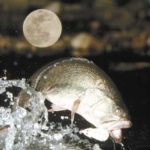
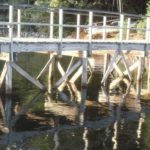
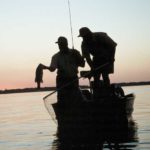
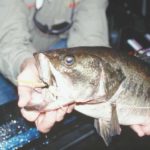

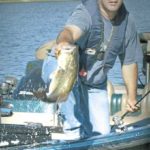
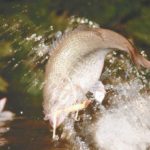


Be the first to comment